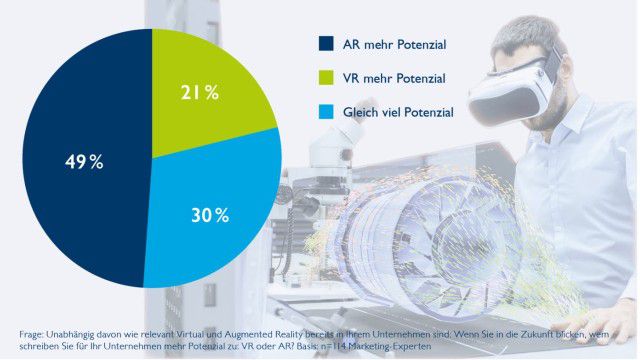As the Federal Association of the Digital Economy (BVDW) found out in a survey of 114 marketing experts from member companies, AR and VR are also making slow but steady progress in Germany. Half of the marketers see the greater potential in augmented reality. Only 21 percent expect virtual reality to benefit their company. For the remaining 30 percent of the survey participants, the benefit ratio of the two technologies is balanced.

Photo: BVDW
Maik Herrmann from the agency Publicis states: “While virtual reality is still strongly linked to entertainment offers, augmented reality has already found its way into professional use in particular”. Herrmann is Chairman of the Virtual and Augmented Reality Focus Group at the BVDW. According to him, it is becoming apparent that both technologies will play an important role in the vast majority of companies.
This is confirmed by an analysis by IDC: the market researchers estimate global sales in 2018 with AR devices at $ 0.8 million and with VR headsets at $ 8.1 billion. By 2020, these figures are expected to be 26.7 billion and 39.2 billion dollars, respectively. This would mean an average annual market growth of 140 percent in the AR hardware segment, while the increase in the larger VR segment would still be 48 percent per annum.
According to the BVDW analysis, every second company is currently busy with VR films in 360 degrees alone – either actively (27 percent) or still in the planning (23 percent). Only one in five respondents does not want to know anything about this technology either today or in the future. 13 Percent of the respondents currently use “real-time information”, i.e. the typical AR scenario in which live images are combined with additional virtual content. A further 29 percent have corresponding plans and 38 percent consider this to be “exciting”.

Photo: BVDW
“The interest in the technology is huge,” observes BVDW expert Herrmann. “However, as is not unusual for new technologies, there is still a lack of willingness to invest.” According to the BVDW study, users want to test for the first time, the average budgets are only around 70,000 euros per year. Nevertheless, Herrmann believes that VR and AR are currently proving to be business-ready technologies: “Very different budgets will soon be called up here.”
Meanwhile, there are many examples of how augmented reality can be used – for example, to improve the much-cited customer journey. Perhaps the most popular is the world’s largest Starbucks branch in Shanghai, which the café chain operator has reinvented digitally together with the Chinese Internet group Alibaba. With the app open, customers can point their smartphones at roasting kegs, coffee machines or furnishings to retrieve entertaining, informative or even money-saving additional information.
The French cosmetics giant L’oreal has also attracted a lot of attention, offering its customers, among other things, the “Style my Hair” app. Users can use it to re-style themselves in a 3D environment and find out on their smartphone which hairstyles and hair colors suit them – the perfect preparation for a visit to the hairdresser.
But it is not only the retail trade that is working to make the natural boundary between real and virtual worlds disappear. In medicine, for example, scientists are working on surgical procedures for surgeons, who usually do not have a free hand, but always have to take their eyes off the patient and look at screens, for example, to monitor vital data or retrieve certain information. For the foreseeable future, they will be able to use special data glasses to have details relevant to the operation displayed – also via voice command.
At the Chair of Computer Science Applications in Medicine & Augmented Reality, the Technical University of Munich is also working with a system that projects a three-dimensional image to the doctor during an operation on the affected area of the body where an intervention is to be performed. This could allow more precise work and limit the risk of surgery.









